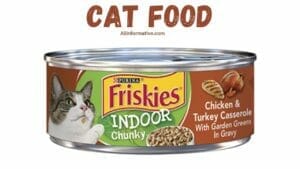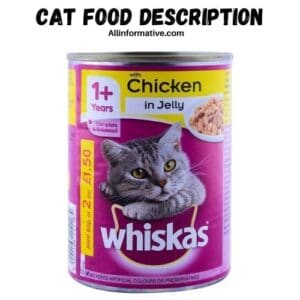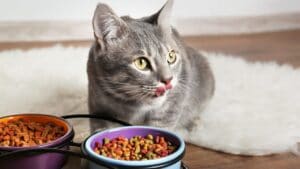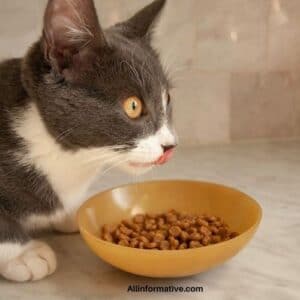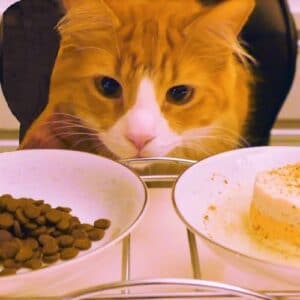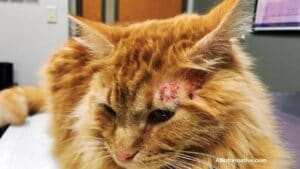The Cats are water proteins, fats, carbohydrates, vitamins and minerals. To achieve right balance of nutrients pet food manufacturers blend mixtures of ingredients including meat and fish, vegetables, cereals, vitamins and minerals. It produce foods that will satisfy the nutritional requirements of your cat. In this page we talk about Cat Food | The Original and Healthy Cat Food Guide.
Contents
Cat Food:
They are water proteins, fats, carbohydrates, vitamins and minerals. To achieve right balance of nutrients pet food manufacturers blend mixtures of ingredients including meat and fish, vegetables, cereals, vitamins and minerals. It used to produce foods that will satisfy nutritional requirements of your cat.
It is important to remember that nutritional needs of a cat are distinct and different to humans. A cat requires 41 essential nutrients for healthy body function. They are classified into 6 main nutrient groups. They are water proteins, fats, carbohydrates, vitamins and minerals.
To achieve the right balance of nutrients pet food manufacturers blend mixtures of the ingredients including meat and fish, vegetables, cereals, vitamins and minerals. It produce foods that will satisfy the nutritional requirements of your cat. Cat owners who feed a complete commercial cat food can have confidence they are addressing their cat’s nutritional needs.
Normally in country no care is taken of a cat’s food and he is left to live. It is said from his hunting but when he is hungry, he hunts pantry’s provisions far more than mouse. Because he does not pursue them and never watches them by need, but by instinct and attraction. And so, to neglect feeding cat is to render him at same time useless and harmful. While with a few scraps regularly and properly given, cat will never do any damage.
The Best Cat Food Brands:
- Best Overall: Smalls Human-Grade Fresh Cat Food
- The Best Dry Cat Food: Blue Buffalo Indoor Health Natural Adult Chicken & Brown Rice Dry Cat Food
- Best Wet Cat Food: Tiki Cat Emma Luau Variety Pack
- The Best High-Protein Cat Food: American Journey Salmon Recipe Grain-Free Dry Cat Food
- A Best Grain-Free Cat Food: Purina Beyond: Ocean Whitefish and Egg Recipe
- Best Kitten Food: Wellness Complete Health Kitten Formula
- Best Cat Food for Seniors: Halo Grain Free Senior Holistic Chicken & Chicken Liver Dry Cat Food
Worst Cat Food Brands:
- Mars Petcare cat food brands (Royal Canin, Sheba, Whiskas, Iams, Nutro, Temptations, Greenies)
- Nestle cat food brands (Friskies, Fancy Feast, Beyond, Deli Cat, Muse, Kit & Kaboodle, Kitten/Cat Chow, Purina ONE, Purina ProPlan, Purina ProPlan Veterinary Diet)
- JM Smucker cat food brands (Rachel Ray Nutrish, 9Lives, MeowMix, Natural Balance)
- Colgate-Palmolive cat food brands (Hill’s Science Diet)
- General Mills cat food brands (Blue Buffalo, Blue Wilderness, Blue Basics, Blue Carnivora, Blue True Solutions, Blue Freedom, Blue Natural Veterinary Diet)
Cat Food Description:
Cat food is food for consumption by cats. Cats have specific requirements for their dietary nutrients Certain nutrients, including many vitamins and amino acids. These degraded by temperatures, pressures and chemical treatments used during manufacture. Hence must added after manufacture to avoid nutritional deficiency.
The idea of preparing specialized food for cats came later than dog food and dog biscuits. This was likely due to idea that cats could readily fend for themselves. In 1837, French writer Mauny de Mornay critiqued this idea:
It thought wrongly that cat, ill-fed, hunts better and takes more mice, this too is a grave error. The cat who is not given food is feeble and sickly. As soon as he has bitten into a mouse, he lies down to rest and sleep. While well fed, he is wide awake and satisfies his natural taste in chasing all that belongs to rat family.
Spratt, which began by making dog biscuits, appears to also have been first commercial producer of cat food. During 19th century and early 20th centuries, meat for cats and dogs in London, frequently horse meat. That was sold from barrows by itinerant traders known as Cats’ Meat Men.
Commercial foods:
Most store bought cat food comes in either dry form. That is also known in the US as kibble or wet form, canned or in pouches. Some manufacturers sell frozen raw diets and premix products to cater to owners who feed raw.
Dry food:
Dry food that is 8–10% moisture. It is generally made by extrusion cooking under high heat and pressure. Fat may then sprayed on food to increase palatability and other minor ingredients. Such as heat sensitive vitamins which destroyed in extrusion process, may be added.
Dry food is most often packed in multi-wall paper bags. Sometimes with a plastic film layer; similar bag styles with film laminates or coextrusions are also use.
Wet food:
In much of Europe, the UK and the US, canned or wet food 75–78% moisture generally comes in aluminum or steel cans in 3 oz, 5.5 oz, and 13 oz sizes. It is also sold in foil pouch form.
Renal Food:
A renal diet formulated for cats that are living with chronic kidney disease or CKD. This is highly prevalent condition in feline population and is most common in aging and older domesticated feline. It has been shown that lifespan of cats experiencing CKD can be extended by as much as 2 years when receiving therapeutic diets rather than regular maintenance diets. These diets are low in protein, low in phosphorus. They have a high energy density, higher fat content and include omega 3 fatty acids.
Renal diets with low protein adopted by a number of big pet food manufacturers. Although diet of healthy cat should be high in protein at times it is medically necessary for cat to eat low protein diet. For cats living with chronic renal disease, low protein diets lower amount of nitrogenous waste in body, helping to decrease strain put on the kidneys. The exact level of protein that is needed for therapeutic CKD diets is unclear.
Formulating these diets with higher amounts of fat is important to make sure food is palatable in absence of protein and promote an increased caloric intake. The higher fat content will also spare use of protein for energy and help decrease stress on kidneys. Omega 3 fatty acids are included in therapeutic diets because of their anti-inflammatory properties to aid diseased kidneys.
Facts about Cats:
- The oldest known pet cat existed 9,500 years ago
- Cats spend 70% of their lives sleeping
- A cat was the Mayor of an Alaskan town for 20 years
- The record for the longest cat ever is 48.5 inches
- The richest cat in the world had ?7 million
- In 1963 a cat went to space
- House cats share 95.6% of their genetic makeup with tigers
- A house cat can reach speeds of up to 30mph
- The oldest cat in the world was 38 years old!
- The cat can perform 24 tricks in one minute.
Curious cat qualities:
- Sociable.
- They see you as part of their family.
- Sleep a lot.
- They dream when they sleep.
- They are excellent hunters.
- Their cleanliness is very important.
- They have a very different vision.
- They also have feelings.
What is special about cat?
The Cats believed to the only mammals who don’t taste sweetness. Cats are nearsighted but their peripheral vision and night vision are much better than that of humans.
Cats supposed to have 18 toes, five toes on each front paw; four toes on each back paw. Cats can jump up to six times their length.
An interesting fact that you might not know is that cats also have a “cry” which they use to manipulate humans.
If anything, this proves that even cats know they are evil creatures. And they have to impersonate our children to try and manipulate us into doing their bidding.
What do cats naturally eat?
The diet of wild or domestic cats mainly made up of small rodents. Such as mice and rats. Other common prey are moles, shrews, rabbits, and birds.
However, these cats will prey on almost any small animal, such as lizards, snakes and large insects.
Packaging and labeling:
In the United States, cat foods labeled as “complete and balanced” must meet standards established by Association of American Feed Control Officials. That is either by meeting a nutrient profile or by passing a feeding trial. Cat Food Nutrient Profiles established in 1992 and updated in 2014 by AAFCO’s Feline Nutrition Expert Subcommittee.
The updated profiles replaced the previous recommendations set by National Research Council. Certain manufacturers label their products with terms. Such as premium, ultra premium, natural and holistic. Such terms currently have no legal definitions.
However, “While most of the food supplied comes from within the US. FDA ensures that standards met within our borders even when components come from countries with less stringent levels of safety or label integrity.
Homemade cat food:
Many pet owners feed cats homemade diets. These diets generally consist of some form of cooked or raw meat, bone, vegetables and supplements. Such as taurine and multivitamins. Homemade diets either follow a recipe, such as BARF diet which provides a series of options for pet owner to make. Rely on constant rotation of ingredients to meet nutrient requirements.
A study conducted that analyzed 95 homemade BARF diets. Also found that 60% of these nutritionally imbalanced in either one. Or combination of calcium, phosphorus, vitamin D, iodine, zinc, copper or vitamin A content.
Another 2019 study on range of homemade diet recipes found online and in books. It has also found nutritional inadequacies. The authors mention that vegetarianism and support for organics food are common reasons for trying such a diet. But does not specifically address adequacy of vegetarian or organic diets.
Food allergy:
Food allergy is a non-seasonal disease with skin and gastrointestinal disorders. The main complaint is excessive scratching, pruritus which is usually resistant to treatment by steroidal anti-inflammatory drugs. The exact prevalence of food allergy in cats remains unknown.
In 20 to 30% of the cases, cats have concurrent allergic diseases; atopy, flea, allergic dermatitis. Reliable diagnosis can only made with dietary elimination-challenge trials. Allergy testing is necessary for identification of causative food component. Therapy consists of avoiding offending food component.
Conclusion:
Cat food is food for consumption by cats. Cats have specific requirements for their dietary nutrients Certain nutrients, including many vitamins and amino acids. Cats are water proteins, fats, carbohydrates, vitamins and minerals. To achieve right balance of nutrients pet food manufacturers. Blend mixtures of ingredients including meat and fish, vegetables, cereals, vitamins and minerals.
